
PRESS RELEASE
FOR IMMEDIATE RELEASE
June 30, 3035
Publicity Contacts:
Wendy Brickman
Brickman Marketing
Brickman@brickmanmarketing.com
831-594-1500
Sherry Flumerfelt
Western Flyer Foundation
sherry@westernflyer.org
(831) 200-8259
Western Flyer Returns After 100-Day Voyage Bridging Past and Future
Cargo Includes Scientific Data, Community Stories, and Student Discovery
MOSS LANDING, CA — On Tuesday, June 24, the storied wooden vessel Western Flyer returned home after a 100-day, 4,700-mile expedition retracing the legendary 1940 journey of John Steinbeck and Ed Ricketts to Mexico’s Gulf of California. But this was no reenactment. Eighty-five years later, the Flyer set out with a new kind of crew — students, scientists, educators, artists, and community partners — united by a shared mission: to spark curiosity through science, education, and storytelling.
As the boat pulled into Moss Landing, a small crowd gathered to welcome the Western Flyer home — a modern echo of its first return from the Gulf, this time carrying data and stories instead of specimens.
“Bringing the Western Flyer back to the Gulf wasn’t just about retracing a voyage — it was about building something new with students, communities, and scientists on both sides of the border,” said Sherry Flumerfelt, Executive Director of the Western Flyer Foundation. “We saw students light up at the microscope, researchers discover new collaborations, and people show up with open hearts. That’s the real legacy — and it’s still unfolding.”
A Modern Voyage of Discovery
Over the course of the expedition, the Western Flyer:
- Spent 100 days at sea, covering 4,700 miles
- Made 22 stops, bringing hands-on education and outreach to 16 coastal communities
- Collaborated with 65 institutions, including universities, government agencies, conservation organizations, and schools
- Engaged 700 students in bilingual, place-based marine science
- Welcomed 4,000 visitors aboard for tours
- Reached over 10,000 people through public events
And to keep the crew going? 315 pots of coffee, 1,000 eggs, 100 pounds of potatoes, and 50 loaves of bread.
At 43 different research sites, students, scientists, and educators worked side by side — deploying oceanographic instruments, exploring seamounts, towing plankton nets, and documenting everything from nudibranchs in mangroves to the surprise return of Humboldt squid. From piloting remotely operated vehicles to conducting intertidal surveys, from observing whales to examining the tiniest plankton, the science was hands-on, collaborative, and locally grounded, revealing not only the Gulf’s hidden stories but also new possibilities for the next generation.

Beyond the Science
Not all cargo was physical — and none of it was biological. Instead of jars of preserved specimens, like those collected in 1940, the Flyer returned with data, stories, and friendships forged across borders.
In plazas, along sunlit docks, and aboard the Western Flyer, the crew connected with conservationists, fishermen, scientists, artists, and students — all eager to share knowledge, histories, and hopes for their communities and the sea.
Alongside research results and field notes came unexpected treasures: hand-carved wooden boats from Santa Rosalía, student artwork inspired by Steinbeck’s The Pearl and Of Mice and Men from San José del Cabo, and a handmade doll from Cabo Pulmo, offered for safe passage.
From the Captain’s Log
“I’ve captained a lot of boats, but nothing like this,” said Captain Paul Tate. “The history, the science, the students, the community — this voyage had a different kind of weight. You could feel it in your bones.”
From 35-knot gusts rounding Point Conception to bioluminescent dolphins streaking through the bow wake under a blood moon, the journey offered more than just science or scenery. There were nights of laughter in tight quarters, quiet mid-watches beneath starlit skies, and moments that connected the present to the past in ways no one expected.
In Puerto Escondido, the crew was welcomed by the children of Leopoldo Perpuli — the guide who led Steinbeck and Ricketts into the hills in Chapter 16 of The Log from the Sea of Cortez. In an unforgettable moment, Captain Tate shared a toast with Perpuli’s son Fidencio, using a barnacle-covered shot glass salvaged from the original 1940 voyage. The family also presented an inscribed photo of their father with Steinbeck and Ricketts, now proudly displayed in the Flyer’s galley.

Steinbeck wrote in The Log from the Sea of Cortez: “This trip had dimension and tone. It was a thing whose boundaries seeped through itself and beyond into some time and space that was more than all the Gulf and more than all our lives.”
“You could feel it,” Tate said. “That sense of something larger than us — echoing back from the past and reaching somewhere new. The communities we connected with, from major cities to remote fishing villages, brought a depth of collaboration and generosity that added a new dimension — one Steinbeck and Ricketts could never have imagined. And now we get to explore that ‘somewhere new’ together.”
Echoes from 1940
On April 22, 1940, the Monterey Peninsula Herald reported the Flyer’s return from the Gulf, describing “a valuable cargo of scientific specimens” and a crowd of nearly 50 gathered on the wharf.
📰 Read the original article as it appeared that day.
To explore more stories, photos, and updates from the journey, visit:
👉 www.westernflyer.org/baja2025
👉 www.westernflyer.org

